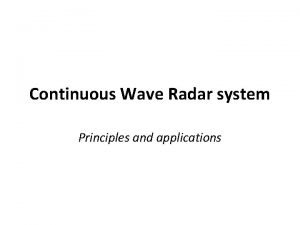Can fullyfocused altimeter range data provide enhanced detection

- Slides: 1

Can fully-focused altimeter range data provide enhanced detection of coastal currents in the Nova Scotia Shelf? : Preliminary diagnosis 1 2 1 3 Hui Feng , Alejandro Egido , Doug Vandemark and Claire Dufau 1 Ocean Process Analysis Lab , University of New Hampshire. , NH, USA 2 NOAA – Laboratory for Satellite Altimetry/GST Inc. , MD, USA 3 CLS Space Oceanography, Toulouse, France II. Data and Methods I. Introduction This study seeks to evaluate the potential of so-called Fully-Focused SAR (FFSAR) mode altimetry (Egido and Smith, 2017) to improve detection of nearshore currents that are critical advective pathways within narrow shelf-sea systems. The region of interest is the Nova Scotian Shelf and, in particular, the coastally trapped Nova Scotia current (NSC). The outer edge of this current resides between 1060 km from the coast and previous efforts using conventional altimetry have failed to adequately capture expected resolutions of NSC dynamics. FFSAR (NOAA) Fully Focused SAR data (Egido and Smith, 2017) ~80 Hz Raw retracked data SSHa , SWH, Sigma. Ku PLRM/LRM (RADS) (Pseudo Low Resolution Mode) (Remko, 2014) ~1 Hz Raw data with no flags SSHb, SWH , Sigma. Ku, MSS, Geoid, Orbit, rms in SSH/SWH/Sig and etc. , FFSAR SSHa is the Sea Surface Height wrt. RADS SSHb = GDREorbit-Range WGS-84 ellipsoid, that is WGS 84 –Range (corrected ONLY by instrument effects ) corrected ONLY by instrument corrections Cryosat-2 (CS 2) FFSAR data (Table 1) of sea surface height (SSH=Orbit ellipisoid– Range), significant wave height (SWH) and backscattering coefficient I Ku band (Sigma 0) and SSH-derived cross-track (nearly alongshore) geostrophic current (Vg ) will be assessed. One reference baseline is CS 2 unfocused SAR processing, the pseudo-low resolution mode (PLRM) (Scharroo, 2014). The objectives seek to evaluate possible: a 1) increased data recovery nearer to the coast, 2) reduced noise of SSH, SWH, Sigma 0 and SSHbased Vg) at scales inside of 50 km, and 3) identification of fine-scale signals like internal waves in the FF-SAR data, in comparison with other processing approaches Cryostat-2 SAR mode only Cryostat-2 both PLRM (from SAR mode) and LRM mode Table 1. CS 2 Altimeter data (2014 -2016) availability in the Nova Scotia Shelf • For PLRM: 1 Hz data from RADS, a set of rms parameters estimated from 20 Hz measurements are available, “range_rms_ku”, std dev of range-Ku “swh_rms_ku”, std dev of SWH-Ku “sig 0_rms_ku”, std dev of Sigma- Ku • For FFSAR: 80 Hz data, 1 Hz FFSAR parameters and corresponding noises (i. e. rms) are estimated as the mean and the standard deviation of geophysical parameters within 1 second as follows: § first, FFSAR: 80 Hz data is smoothed by a ¼ second(~20 Hz) running-mean § and then mean and rms are estimated within 1 second interval Figure 1 Regional map with Cryosat-2 (CS 2) FFSAR and PLRM data availability in space (left) and time (right) for 3 years (2014 -2016 ) near Nova Scotia. The isobars of 100 m-, 200 -m and 1000 m are also shown. III. Along-Track Example In such a way, we want to objectively compare noise levels of FFSAR(1 Hz) parameters with those from RADS PLRM(1 Hz) V. FFSAR vs. PLARM Geostrophic Current Vg • Estimate cross-track geostrophic current Vg • a) a) Noise (rms) calculations in 1 Hz data Fig 2. A track data in 01/22/2015 is used here b) b) a) . Fig. 8. Regional map with the CS 2 pass data are used for geostrophic current analysis c) c) b) where ADT=SSH-Geoid is the instant Absolute Dynamic Topography, FFSAR vs. PLRM (1 hz as example here) with no geophysical corrections; f is the Cirolis parameter; s is alongtrack position, n is the span of the data points along a track; O-O Buoy d) Fig. 3 a) SSH, b) SSH-MSS; c) MSS and d) MDTs. In d) Dippio. MDT is a ROMS model (Wilkin et al. , 2018), showing its gradient is less steep than MDT=MSS-Geoid, the latter with “unphysical” small-scale variations due likely to inaccurate Geoid Fig. 5 a) ADT=SSH-Geoid; b) ADT gradient derived crosstrack geostrophic current Vg ( negative SW) ( n=0 case) showing 1) FFSAR noises are lower than PLRMs, and 2) magnitude of ADT(1 hz) Vg (~6 km) is much higher than ones in buoy and Glob. Current (www. globcurrent. org, Rio et al. , 2014), and 3) we will have to consider objective length scale to smooth (low pass) FFSAR data Fig. 4 a) SSH, b) SWH, and c) Sigma 0 (a 3 db bias applied to RADS sigma) with noise bars( 6*std), clearly showing FFSAR SSH&SWH noises are lower than PLRMs while FFSAR Sigma 0 noise is higher IV. FFSAR vs. PLRM in SSH, SWH, Sigma 0: bulk statistics (a ) a) b) c) Fig. 9. Normalized distributions of ADT derived Vg from 1 Hz PLRM vs. FFSA, a)/b)/c) for span n=0, 1, 3 n=0 representing length scale ~6 km, ~18 km and ~36 km, respectively. Note that 1) Vg noise in FFSAR is clearly reduced wrt. PLRM, 2) the mean magnitude of Vg in both FFSAR and PLRM is [16 cm/s -12 cm/s], seemingly >50% higher than expected. span n =3 a) (b ) b) c) a) b) c) Fig. 10. This is the case the span n=3 with a length scale ~36 km; a) scatter plot (Vg from 1 Hz PLRM vs. FFSAR; b) and c) Vg difference between 1 Hz PLRM and FFSAR as a function of distance to the coastand water depth, respectively, showing 1) correlation is moderate, and 2) noise seems related to the distance to land water depth VI. Preliminary conclusions Fig. 6. Normalized distributions from top to bottom (a) SSH, SWH and Sigma, for (FFSAR 1 hz vs. PLRM 1 hz). Significant biases exist between FFSAR and PLRM in SWH (~1 m) and Sigma 0 (~3 d. B, respectively) and little difference is seen in the raw SSH; (b) their corresponding noises, . Noise reduction of the FFSAR data in SSH and SWH, but not in Sigma 0. Fig. 7. 1 Hz noise (i. e rms ) estimates of a) SSH, b) SWH and c) Sigma 0 as a function of SWH (FFSAR 1 hz vs. PLRM 1 hz), respectively, showing the improved precision of the FFSAR processing methods wrt. PLRM - a factor of 2 in both SSH and SWH, but not in Sigma 0. References Egido, A. and W. Smith, 2017 “Fully focused SAR altimetry: theory and applications”, IEEE TGRS, 2017. Scharroo, A. , “RADS RDSAR algorithm theoretical basis document version 0. 3, CP 4 O project report, ” NASA, Washington, DC, USA, 2014. [Online]. Available: http: //www. satoc. eu/ projects/CP 4 O/docs/tud_rdsar_atbd. pdf Rio, M. -H. ; Mulet, S. ; Picot, N. Beyond GOCE for the ocean circulation estimate: Synergetic use of altimetry, gravimetry, and in situ data provides new insight into geostrophic and Ekman currents. Geophys. Res. Lett. 2014 Acknowledgements Work is funded through the NASA Science Mission Directorate and NASA Ocean Surface Topography Science Team. Some conclusions drawn • Biases exist between FFSAR and PLRM in SWH ( ~1 m) and Sigma 0 (~3 d. B) (Fig. 6), and little difference is seen in SSH, not consistent with the open ocean case (E&S, 2017). The Sig 0 bias is related to a correction applied to the PLRM in RADS. We are investigating SWH bias, likely from an issue of the retracking of FFSAR waveforms. • The noise reduction (improved precision) of the FFSAR data wrt. PLRM is apparent for SSH and SWH (up to a factor of 2) (Figs 6, 7 9), consistent with what shown by E&S, 2017) • the noise reduction in FFSAR ADT derived geostrophic current Vg wrt. PLRM is also seen (Fig. 9). Future steps in terms of FFSAR vs. PLRM • Explore a more objective cross-shelf length scale to derive along-shelf coastal current Vg • Investigate if geophysical corrections (e. g. tide, DAC etc. ) should be applied ! • Understand what small-scale signals ( in Fig. 5) represent, current, internal waves, etc? • Use Sentinel-3 SAR mode data with regular time-space coverage for further analysis in the region NASA OSTST meeting , Azores Archipelago, Portugal, 27 -28 September 2018

